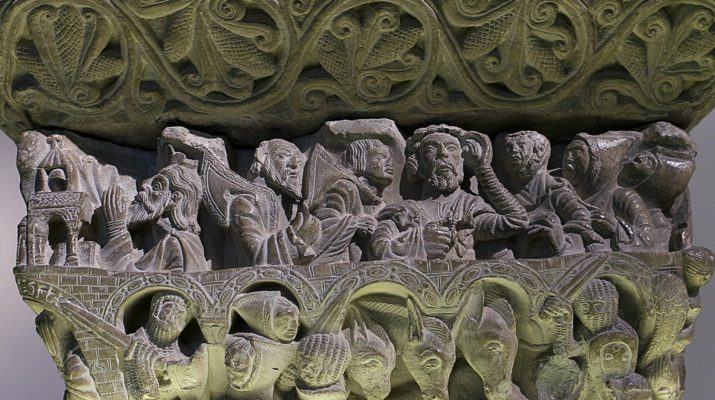Job 19:23-27a
Ordinary C50
23 “O that my wordsA wereB written down!C
O that they were inscribedD in a book!E
A “words” = millah. From malal (to say, speak; often used in a poetic sense). This is something said – a word, speech, talking, or discourse.
B “were” = natan. This is to give, put, set, offer. It is to give literally or figuratively.
C “written down” = kathab. This is to inscribe, write, record, or decree.
D “inscribed” = chaqaq. 19x in OT. This is to inscribe, carve, or decree. It can be a lawmaker/commander or a staff/scepter. Literally, this is engraving, but it implies enacting a law because laws were carved into stone or metal.
E “book” = sepher. Perhaps from saphar (to tally or record something; to enumerate, recount, number, celebrate, or declare). This can be writing itself or something that is written like a document, book, letter, evidence, bill, scroll, or register.
24 O that with an ironF penG and with leadH
F “iron” = barzel. From the same as Birzoth (a name meaning holes). Root may mean to pierce. This is iron as something used as a cutting implement. It can also specifically mean ax head.
G “pen” = et. 4x in OT. Perhaps from iyt (to fly, rail, swoop on literally or figuratively). This is a stylus or pen as something that makes long strokes.
H “lead” = ophereth. 9x in OT. From the same as opher (stag, fawn, hart); from aphar (to throw dust, be dust); from aphar (dust as powdered, perhaps gray colored; ashes, powder, ground, dry earth, clay mud, or rubbish). This is lead, the metal, since it is dust-colored.
they were engravedI on a rockJ forever!K
I “engraved” = chatsab. This is to hew or cut material like wood or stone. It can also be to dig, quarry, split, or engrave.
J “rock” = tsur. From tsur (to confine, cramp, or bind in a literal or figurative sense; to besiege, assault, or distress). This is rock, stone, cliff, boulder, rocky. It can also be a refuge, a way to refer to God.
K “forever” = ad. From adah (to advance or continue; to take away or remove; adorning oneself with ornaments). This is old, perpetuity, eternity. It is a duration going back or forward.
25 For I knowL that my vindicatorM livesN
and that in the endO he will standP upon the earth;Q
L “know” = yada. This is to know, acknowledge, advise, answer, be aware, be acquainted with. Properly, this is to figure something out by seeing. It includes ideas of observation, recognition, and care about something. It can be used causatively for instruction, designation, and punishment.
M “vindicator” = gaal. This is to redeem someone or something according to kinship laws. So, it could be acting on a relative’s behalf to buy back their property, to marry one’s brother’s widow, etc. This could be more briefly translated as to redeem, acts as kinsman, or purchase. As a noun, it could be deliverer or avenger.
N “lives” = chay. From chayah (to live or keep alive literally or figuratively). This is alive, living, lifetime. It can also be used to describe someone’s age. It can refer to animals, plants, water, or a company or congregation of people. It is life in a very broad sense.
O “end” = acharon. From achar (to be behind, delay, be late, procrastinate, continue). This is end, last, coming behind, to loiter, later. It can also refer to the west.
P “stand” = qum. To arise, stand, accomplish, establish, abide. This is rising as in rising against, getting up after being sick or asleep, arising from one state to another, becoming powerful, or rising for action. It can also be standing in a figurative sense.
Q “earth” = aphar. Related to “lead” in v24. See note H above.
26 and afterR my skinS has been destroyed,T
R “after” = achar. Related to “end” in v25. From achar (see note O above). This is after or the last part, following.
S “skin” = or. Perhaps from ur (to be made naked, exposed, or bare). This is skin, hide, or leather. It can also refer to a body.
T “destroyed” = naqaph. 19x in OT. This is to strike, cut down, surround, destroy, corrode, knock together, or enclose. It can be to surround as a guard or like the sea. It can meaning coming to the end of a festival time or enclosing in a net or trap.
then in my fleshU I shall seeV God,W
U “flesh” = basar. From basar (being a messenger, publish, carry preach; properly, this is being fresh, rosy or cheerful as one bearing news). This is flesh, the body, fat, skin, self, nakedness, humankind, or kin. It can also refer to private parts.
V “see” = chazah. This is to gaze at – to see or behold. It can also refer to perceiving as a mental process or looking at something with pleasure. It can be used particularly to mean seeing a vision.
W “God” = Eloah. From el (God or god). This is God or a god.
27 whom I shall see on my side,
and my eyesX shall behold,Y and not another.Z
My heartAA faintsBB withinCC me!
X “eyes” = ayin. This is eye in a literal or figurative sense so eye, appearance, favor, or a fountain (the eye of the landscape).
Y “behold” = raah. This is to see in a literal or figurative sense so stare, advise, think, view.
Z “another” = zuwr. This is one who comes from someone else – a stranger. It is one who stops for lodging. Figuratively, it can also mean profane or one who commits adultery.
AA “heart” = kilyah. Related to “faints” in v27. Perhaps from keli (something that was prepared – any implement, utensil, article, vessel, weapon, or instrument; also includes jewels, weapons, bags, carriages, and furniture); from kalah (see note BB below). This is inward parts, such as kidney or heart. It can also be inmost being as feelings, mind, or within.
BB “faints” = kalah. This is to end, be finished, complete, prepare, consume, spent, or completely destroyed.
CC “within” = cheq. Root may mean to enclose. This is bosom in a literal or figurative sense. So, this could be arms, lap, or midst. It can also be care or cherish.
Image credit: “Navarre Museum. Master of the cloister of the cathedral of Pamplona. Historiated capital on the Story of Job. From the cloister of the Romanesque cathedral of Pamplona (ca. 1130-1140).” Photo by Jl FilpoC, 2019.




